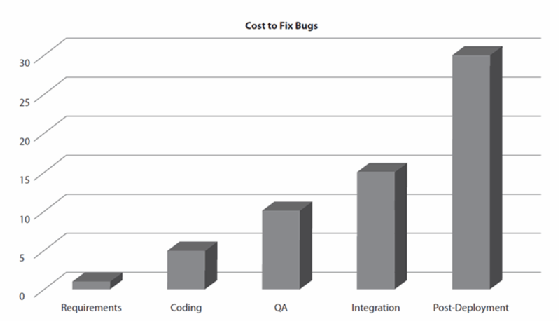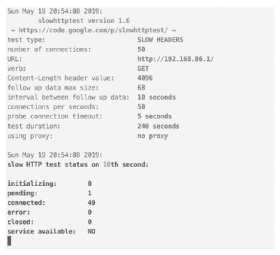Software security testing and software stress testing basics
In this excerpt from Ric Messier's book, learn why software security testing and stress testing are critical components of an enterprise infosec program.
Security, as defined by author Ric Messier, is "a concept propped up by the three legs of confidentiality, integrity and availability."
This is known as the CIA triad, and Messier noted that these security legs remain essential to infosec -- particularly when it comes to software security testing and stress testing.
Messier laid it out simply:
- Confidentiality means information shouldn't be shared broadly.
- Integrity means a soundness of systems and information.
- Availability means information can be accessed when needed.
"It's worth noting that actions don't have to be malicious in nature for these properties to be compromised, resulting in a security issue," Messier wrote in his book, Build Your Own Cybersecurity Testing Lab: Low-cost Solutions for Testing in Virtual and Cloud-based Environments. For example, losing power -- which is likely a nonmalicious act -- can still hinder the availability of machines and affect someone's ability to work. Likewise, a failing hard drive or bad driver can corrupt data and result in a security incident.
 Ric Messier
Ric Messier
Performing software security testing to find such implications -- malicious or otherwise -- is an essential component of any enterprise security program. "It's not just about protecting against bad people doing bad things," Messier wrote. "Security testing has to ensure software and systems are capable of being resilient to any failure."
This excerpt from Chapter 1 of Build Your Own Cybersecurity Testing Lab dives into the world of software security testing and stress testing. Learn about common software vulnerabilities and why stress testing mission-critical applications is crucial.
Build Your Own Cybersecurity Testing Lab
Download a PDF copy of Chapter 1.
Read a Q&A with author Ric Messier.
Purchase your copy here.
Software Security Testing
It's common for software to undergo quality assurance testing. Of course, there are no rules as to how that happens or how detailed it is. It's a long-held maxim that fixing bugs is cheaper the earlier in the process they are identified. Figure 1-2 is a graph showing one estimate of the cost difference between finding a problem in the requirements stage and all the way up to post-deployment/release. Different sources will provide different multiples for the different stages. The baseline is in the requirements stage, though you wouldn't fix a bug in the requirements, though you could identify bad requirements that could introduce problems. Given that, the best place is to identify bugs during the coding or development stage.
The rationale is that it costs more in testing because of the rework involved. A programmer has to get the bug report, validate the bug, identify where the bug actually is in the code, then fix the bug before handing it back to the testing team, where it all has to be tested again. The reason it's more expensive post-deployment in a traditional software release model where the software is packaged up and has to be sent back to the customer again is because the bug not only has to make it all the way back to the developer, following the same process outlined above, but the package has to be built and redeployed to the customer. These costs are coming down a little, since it's not like CDs have to be shipped like they may have a decade or more ago. However, there is still a lot of cost involved in the people who have to be involved in the redevelopment, retesting, and redeployment. As well as the cost of any shipping, including hosting it on a web site where it can be downloaded.

Bugs can fall into a security bucket. When it comes to security vulnerabilities, the costs may increase significantly, and they may not be limited to the software company. A security vulnerability may expose any customer that uses that software to attack, which could incur damage or losses to that customer. A study by the Ponemon Institute released in 2018 suggests that the cost of a data breach averages $3.86 million. The study says this is an increase of 6.4 percent over the year before. Given the number of breaches that occur each year, this is a significant amount of money globally. The software company that distributes vulnerable software may not be liable today in the case of that software being part of the reason an attacker gained access, but that may change over time.
This brings us to the first kind of testing that you may be doing. Software security testing looks to try to root out security-related vulnerabilities within software. Ideally, this testing is being done early in the development stream, but it may not be. In fact, some companies have something called bug bounties. Independent testers may perform testing on released software at home in order to identify vulnerabilities that they will get paid for telling the software company about. If you are one of these independent testers, you need a place to perform this testing, which means you need a lab.
The Open Web Application Security Project (OWASP) maintains a list of common vulnerabilities that are known to exist in software applications. This is a list that is updated as the commonality of vulnerabilities increases or decreases year by year. The current list at the OWASP web site (www.owasp.org) is from 2017, which doesn't make it out of date because there have not been significant changes to the list over years, aside from some consolidation of multiple vulnerability types into a single type, which has opened up some space for some new vulnerabilities. The current list is as follows:
- Injection Injection vulnerabilities stem from a lack of input validation. This allows programmatic content like structured query language (SQL) or operating system commands or even Javascript through the application to be handled by something on the back end. These injection attacks expose critical elements of infrastructure, potentially allowing access to sensitive information or just plain giving an attacker access to issue commands to the system. This could mean a years-long foothold in an environment for an attacker where they can do pretty much anything they would like. While the dwell time numbers referenced above show attackers today being in networks for something over two months, the reality is there are plenty of cases like Marriott, where the attacker was in the network for more than four years. These injection attacks are not only highly common, but they are also an easy attack vector for adversaries to get into the network.
- Broken Authentication Passwords are a common way for attackers to gain access to environments. If it's not people just giving up their passwords to the attacker in a social engineering attack, it's programmers doing bad things with the password. This may include storing the password in clear text somewhere. It may include not using good practices with hashes. It could also be default credentials in use or programs handling authentication allowing weak, easily guessed passwords. This may also mean allowing multiple guesses of the password for services. Computing power is cheap so brute force attacks on passwords are easy. Protecting authentication mechanisms can be done but far too often isn't and attacking authentication is often trivial.
- Sensitive Data Exposure Sensitive data, including passwords or other credentials, is often not protected well enough. There may be a period of time, for example, that data is passing through an application's memory space in plaintext. If it's in memory, it can be captured, which means it's exposed. Sometimes, once a user has been authenticated, there is a session identifier that is used to maintain the session, especially in a web application, which has no ability to maintain the state of a user as part of the protocols used in web applications. If these session identifiers are not properly generated, they can be used to replay credentials, making it seem like an attacker has been logged in, when in fact the authentication was done by the actual user. Session identifiers should also be protected, where possible. This can be done, easily enough, using any number of encryption ciphers. There are libraries for many common ones that can be integrated into any program.
- XML External Entities If an attacker can upload data formatted with the eXtensible Markup Language (XML), they may be able to get the system to execute code or retrieve system data. This is a form of an injection attack. An XML External Entity attack uses a feature of XML, allowing a system call, which refers to either a program or a file in the underlying operating system. Attackers may be able to perform reconnaissance against an internal network using this attack.
- Broken Access Control Access control is determining who should have access to a resource and then allowing the user to have that access. There are many ways that access control may be broken in an application. A direct object reference is one way. An application may be developed in such a way that there is an assumption that if a function gets called, it has to have been called from another function where the user has already been authenticated. If the attacker goes directly to this page or function in the application rather than the page or function that would normally have been a predecessor, the attacker can make use of the functionality without ever having to authenticate. This can mean the attacker can gain unauthenticated access to a function that provides either administrative functionality or sensitive information.
- Security Misconfiguration All manner of ills falls into this category. Any configuration setting that impacts the security of the application might be set incorrectly, allowing an attacker to take advantage of the misconfiguration. It could be permissions that are left wide open so anyone who has access to the system can view or even change information stored. This can also mean the use of default usernames and passwords. Additionally, it can mean something like a typographic error. Let's say you are configuring a firewall, and you need to block 172.0.0.0/8 because you are receiving what appears to be attack traffic from a large number of addresses in that block. Instead, you enter 171.0.0.0/8. This means you will continue to get attacked while you are, instead, blocking potentially legitimate customers from getting through. There are a lot of areas where either by design or mistake, systems are misconfigured.
- Cross-Site Scripting Cross-site scripting is also an injection attack, using a scripting language injected into the normal web page source. While this is a case of commands being injected, the difference here is that the target of the attack is nothing on the server-side. Instead, a cross-site scripting attack targets the user's system. Any script that is injected is executed within the user's browser. Generally, this means the attacker is looking to gain access to data that may be available within the browser. This may be credentials or session information. It's unusual that a script run within a browser would be able to get access to files in the underlying operating system, but it may be possible with a weak browser or a vulnerability.
- Insecure Deserialization Deserialization is where you take a stream of bytes and put them back into an object that has been defined within a program. Imagine a complex data type consisting of a name, a phone number, a street address, a city, a state, and a zip code. The name, street address, city, and state are all character strings. The phone number may be represented as a string of integer values, and the zip code may also be represented as a string of integer values. When you take all of these values and serialize them, you are converting them just to a long string of bytes. There may be some framing information in the byte stream to indicate where each of these values start and stop, especially if each of the character strings are not fixed size. Strings may be null-terminated, which means the last byte in the string has a numeric value of 0. This can be the framing. Deserialization will take a stream of bytes and put the bytes back into variables in the object. The problem with this is that if the byte stream does not align well with the object, you can end up with failures. If you are trying to put integer characters into variables but the value of that character is way out of bounds, what happens to the program? Insecure deserialization is when the deserialization happens without any checking to make sure what you are getting in is what you expect and it will fit into the object where it's supposed to.
- Using Components with Known Vulnerabilities It is common for complex systems to make use of supporting software. If a system developer or designer uses available components to speed the development of the application or overall system, it is up to that developer/designer to ensure the software underneath what they are developing is kept up-to-date with fixes and updates. There is a well-known example of this. Experian was broken into, in part because of a security flaw in the Apache Struts framework. This is a library that web applications are built on top of by those who are writing Java applications. When you use existing components like libraries or even services like the Apache or Nginx web servers, you are responsible for keeping those components up-to-date. This can be challenging because not all projects make announcements when they have new versions or, especially, when there are security-related updates. However, having out-of-date software packages on a production system is a very common occurrence. Even in cases where downstream packages are updated and there are updates available, some organizations don't have processes in place to keep all software up-to-date. Even if they do, often there is a long delay between the software being available and when it is deployed.
- Insufficient Logging and Monitoring Operating systems and applications often have a limited amount of logging enabled by default, reducing visibility when problems occur. When incidents arise and attackers are in your environment, you want as much data as you can get. There are two standard logging protocols/systems, one for each Linux/Unix and Windows. This means any application that runs on both has to either be able to write to either or else they write their own logs. Even when the facility to generate logs exists, it's still up to the application developer to write logs. This is often overlooked, especially in cases where rapid application development is used. Methodologies like extreme programming, agile development, and rapid prototyping often eschew documentation, which may include logging, because this is a feature that isn't typically requested by users. Operational and security staff may have logging requirements, but end users wouldn't. This means the need for logging is often not addressed. Without logging, you can't monitor behaviors of services and applications. This sort of testing should be handled as part of some sort of quality assurance process during the software development life cycle. However, security testing of software may not be done at all. It's not entirely uncommon for software to be developed without any security testing. Even software that does not offer up network services can have vulnerabilities that may be useful to attackers. Therefore, it's not helpful to believe that because it's a native application that only interacts with files on a local system so there is no chance it could be compromised, lessening the need for security testing. Everything is fair game.
Stress Testing
Most software development projects do not have to worry so much about how much they need to handle, in terms of volume of data or requests. However, any mission critical application should be stress-tested. Keep in mind that not all software runs on general purpose computers. A general-purpose computer is one that is designed to run arbitrary code, meaning if you can write a program for the computer, the computer will run it. Some computers don't have all the relevant pieces that would allow for these arbitrary programs to be run. The software that runs on these types of devices is commonly called firmware because there is no chance to alter it. It's burned onto a chip where it can't easily be changed. It may not be able to be changed at all, though that wouldn't be as common today, considering the prevalence of security vulnerabilities even in hardware devices.
NOTE
These general-purpose computers follow something called a Von Neumann architecture. John Von Neumann outlined this computer architecture in a paper in 1945, describing the components necessary for these computing devices. According to John Von Neumann, and you'll recognize this explanation, a computer needs a processor, which includes an arithmetic logic unit and processor registers; a control unit that can track the instruction pointer in memory; memory that stores the data and program instructions; storage devices; and input/output mechanisms.
Special-purpose devices, especially those of the variety called Internet of Things, are often built using lower-capacity processors. These lower-capacity processors, including the processor necessary for handling network traffic, may fail when there is too much for them to do. Failure in the field wouldn't be such a good thing. You may have an analog telephone adapter, such as one from Cisco or Ooma or some other Voice over IP provider, just as an example. If one of these devices happened to fail because of a large volume of traffic being sent to it, you'd have no phone service. If you were running a business on one of these devices, you may be without phone service. Thermostats, like those from Nest, Honeywell, and other manufacturers, may be subject to failure on stress, without proper testing, which may mean you don't have heating or cooling.
This is not to say that only large volumes of traffic are how you would stress-test devices. Another way to stress-test any piece of software or device is to send it data that it doesn't expect. These malformed messages may cause problems with the application or device. There were a number of ways to crash operating systems 20 years or so ago using these malformed messages. A LAND attack, for example, was when you set the source and destination to be the same on network messages. This would cause stress to the operating system as it tried to send the message to itself over and over, in an endless loop. A Teardrop attack resulted in an unusable operating system when fragmented messages were sent in such a way that the network stack was unable to determine how best to reassemble the fragments. These sorts of unexpected messages lead to unreliable behavior. While most of these sorts of attacks were long ago addressed in operating systems, they are just examples of the types of stress testing that could be done. Just because the networking parts have been ironed out doesn't mean the applications are always best able to deal with bad behavior.

As an example, there are strategies to take down web servers that have nothing to do with unexpected activity or malformed anything. Instead, you can use slow attacks with legitimate requests to a web server. As the intention is to hold open buffers in the web server until no other legitimate request can get through, this is also a form of stress testing. You can see in Figure 1-3 a run of a program called slowhttptest, which is used to send both read and write requests in a manner that the web server can't completely let go of the existing connections.
Stress testing is not about performing denial of service attacks, since the objective is not to deliberately take a service offline. The objective is to identify failures of an application. Filling up a network connection so no more requests can get through is not especially useful when it comes to security testing. This is where clearly understanding the application and the goal of the testing is essential. You can't test anything without understanding what the objective of the testing is. You'll be spinning your wheels without anything useful to show at the end of the day.





